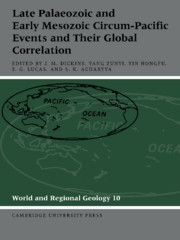Book contents
- Frontmatter
- Contents
- List of contributors
- Preface
- 1 Major global change: framework for the modern world
- 2 Carboniferous-to-Triassic evolution of the Panthalassan margin in southern South America
- 3 Permian and Triassic geologic events in Sonora, northwestern Mexico
- 4 Advances in the correlation of the Permian
- 5 Examples of late Hercynian transtensional tectonics in the Southern Alps (Italy)
- 6 Succession of selected bioevents in the continental Permian of the Southern Alps (Italy): improvements in intrabasinal and interregional correlations
- 7 Permian chronostratigraphic subdivisions and events in China
- 8 Indosinian Tectogeny in the geological correlation of Vietnam and adjacent regions
- 9 Sitsa flora from the Permian of South Primorye
- 10 Late Permian bimodal volcanism in South Primorye
- 11 Syngenetic and epigenetic mineral deposits in Permian and Triassic sequences of the Primorye region
- 12 The mid-Permian: major changes in geology, environment, and faunas and some evolutionary implications
- 13 Variations in the disappearance patterns of rugosan corals in Tethys and their implications for environments at the end of the Permian
- 14 Fluctuations in pelagic environments near the Permian–Triassic boundary in the Mino-Tamba Terrane, southwest Japan
- 15 Late Changxingian ammonoids, bivalves, and brachiopods in South Primorye
- 16 Radiolaria from Permian–Triassic boundary beds in cherty deposits of Primorye (Sikhote-Alin)
- 17 Early Mesozoic magmatism in the Russian Far East
- 18 Transgressive conodont faunas of the early Triassic: an opportunity for correlation in the Tethys and the circum-Pacific
- 19 Triassic biostratigraphy and palaeobiogeography of East Asia
- 20 Classification and correlation of Triassic limestones in Sikhote-Alin on the basis of corals
- 21 Evolution of the platform elements of the conodont genus Metapolygnathus and their distribution in the Upper Triassic of Sikhote-Alin
- 22 Late Triassic North American halobiid bivalves: diversity trends and circum-Pacific correlations
- 23 Upper Triassic Chinle Group, Western United States: a nonmarine standard for late Triassic time
- 24 Otapirian Stage: its fauna and microflora
- 25 Upper Palaeozoic glaciation and Carboniferous and Permian faunal changes in Argentina
- Index
25 - Upper Palaeozoic glaciation and Carboniferous and Permian faunal changes in Argentina
Published online by Cambridge University Press: 13 October 2009
- Frontmatter
- Contents
- List of contributors
- Preface
- 1 Major global change: framework for the modern world
- 2 Carboniferous-to-Triassic evolution of the Panthalassan margin in southern South America
- 3 Permian and Triassic geologic events in Sonora, northwestern Mexico
- 4 Advances in the correlation of the Permian
- 5 Examples of late Hercynian transtensional tectonics in the Southern Alps (Italy)
- 6 Succession of selected bioevents in the continental Permian of the Southern Alps (Italy): improvements in intrabasinal and interregional correlations
- 7 Permian chronostratigraphic subdivisions and events in China
- 8 Indosinian Tectogeny in the geological correlation of Vietnam and adjacent regions
- 9 Sitsa flora from the Permian of South Primorye
- 10 Late Permian bimodal volcanism in South Primorye
- 11 Syngenetic and epigenetic mineral deposits in Permian and Triassic sequences of the Primorye region
- 12 The mid-Permian: major changes in geology, environment, and faunas and some evolutionary implications
- 13 Variations in the disappearance patterns of rugosan corals in Tethys and their implications for environments at the end of the Permian
- 14 Fluctuations in pelagic environments near the Permian–Triassic boundary in the Mino-Tamba Terrane, southwest Japan
- 15 Late Changxingian ammonoids, bivalves, and brachiopods in South Primorye
- 16 Radiolaria from Permian–Triassic boundary beds in cherty deposits of Primorye (Sikhote-Alin)
- 17 Early Mesozoic magmatism in the Russian Far East
- 18 Transgressive conodont faunas of the early Triassic: an opportunity for correlation in the Tethys and the circum-Pacific
- 19 Triassic biostratigraphy and palaeobiogeography of East Asia
- 20 Classification and correlation of Triassic limestones in Sikhote-Alin on the basis of corals
- 21 Evolution of the platform elements of the conodont genus Metapolygnathus and their distribution in the Upper Triassic of Sikhote-Alin
- 22 Late Triassic North American halobiid bivalves: diversity trends and circum-Pacific correlations
- 23 Upper Triassic Chinle Group, Western United States: a nonmarine standard for late Triassic time
- 24 Otapirian Stage: its fauna and microflora
- 25 Upper Palaeozoic glaciation and Carboniferous and Permian faunal changes in Argentina
- Index
Summary
As the western portion of Gondwana in the late Palaeozoic, South America extended over a great range of palaeolatitudes, from southern polar to tropical. At the time of the global lowering of temperature that triggered the “ice age,” strong climatic differences became established between those extreme palaeolatitudes. The portion that was close to the southern palaeopole had low temperatures and was covered by ice sheets; the rest of the continent, which was at lower palaeolatitudes, had higher temperatures (Figure 25.1).
As was the case in the Cenozoic, late Palaeozoic glaciation in South America encompassed several glacial and interglacial stages. In western and southern Argentina, evidence of that glaciation is widespread in sediments whose dates range from as old as Visean–Namurian to as young as late Asselian. Discrimination of discrete glacial stages has been based on striated pavements covered with diamictites and associated varved sediments, dropstone laminites, and so forth (Frakes, Amos, and Crowell, 1969; López Gamundi and Amos, 1983; González, 1983). Sections that afforded doubtful or questionable evidence of glaciation were neglected. Interglacial stages can be recognized on the basis of intercalations of well-sorted sediments, without glacigenic features (Dickins, 1985). Fossiliferous beds, or a transgression with abundant marine fauna between two discrete glacial members, may suggest important defrosting (González, 1990). Elsewhere I have commented on the chronology and durations of those glaciations (González, 1990). Ice sheets could spread over large areas, and occasionally glaciers may have behaved as temporary dams, actually isolating inland seas.
- Type
- Chapter
- Information
- Late Palaeozoic and Early Mesozoic Circum-Pacific Events and their Global Correlation , pp. 235 - 242Publisher: Cambridge University PressPrint publication year: 1997
- 5
- Cited by



